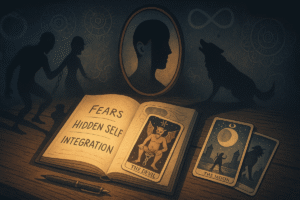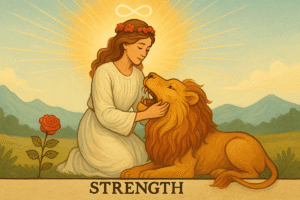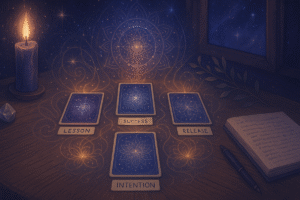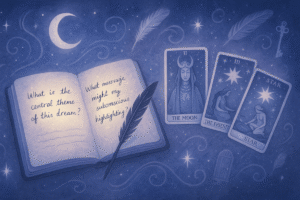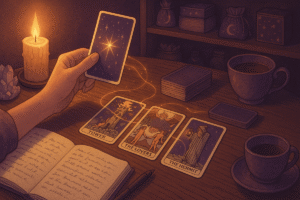Table of Contents
When The Hermit appears in a reading, I often notice people’s immediate reaction is concern. “Does this mean I’ll be alone?” they wonder. But perhaps we’re looking at this card through the wrong lens entirely. What if The Hermit isn’t warning us about isolation, but instead offering something far more valuable?
The ninth card of the Major Arcana stands as one of the most misunderstood archetypes in tarot. While our culture often equates solitude with loneliness, The Hermit invites us to consider a different perspective altogether. This weathered figure, lantern held high against the darkness, represents the conscious choice to step away from external noise and turn inward.
There’s something profound about this image that speaks to a universal human experience. We live in a world that constantly demands our attention, yet meaningful insights rarely emerge from chaos. The Hermit suggests that wisdom requires space to breathe and grow.
Understanding The Hermit’s Sacred Solitude
The traditional imagery of The Hermit offers rich symbolism for reflection. An elderly figure stands on a mountain peak, holding a lantern that illuminates just enough of the path ahead. This isn’t the isolation of someone lost or abandoned, but the deliberate withdrawal of a seeker.
Think about moments in your own life when clarity has emerged. Perhaps it happened during a quiet morning walk, or in those still minutes before the world wakes up. These experiences suggest something important about how insight actually develops. It seems to need space, silence, and time to unfold naturally.
The lantern in The Hermit’s hand particularly fascinates me. It doesn’t light up the entire journey ahead, just the next few steps. This might reflect how genuine wisdom often works. We don’t receive a complete roadmap for life, but rather small illuminations that guide us forward one choice at a time.
Consider this reflection prompt: Where in your life are you trying to see too far ahead, when perhaps focusing on the next step would be more helpful?
The Difference Between Loneliness and Chosen Solitude
Our modern world struggles with the concept of being alone. Social media constantly connects us to others, and we often interpret time spent solo as somehow lacking or incomplete. The Hermit challenges this assumption entirely.
Loneliness typically involves a sense of disconnection or unwanted separation from others. It can feel empty, restless, or painful. Chosen solitude, however, carries a completely different energy. It’s purposeful, restorative, and often surprisingly fulfilling.
I think about the difference between scrolling through social media because you feel isolated versus intentionally putting your phone away to spend time with your own thoughts. The external behavior might look similar, but the internal experience is worlds apart.
The Hermit represents this second type of aloneness. It’s the solitude that allows you to hear your own voice clearly, without the interference of others’ opinions, expectations, or energy. This kind of space often reveals things about ourselves that remain hidden when we’re constantly engaged with the outside world.
What would happen if you viewed your next period of solitude as an opportunity rather than something to endure?
Turning Down External Noise
One of the most powerful questions The Hermit card raises is this: Where in your life do you need to turn down external noise? This inquiry can reveal surprising answers.
External noise isn’t just literal sound, though that certainly counts. It includes the constant stream of opinions from social media, the pressure to make decisions quickly, the endless notifications competing for our attention, and even well-meaning advice from friends and family.
Sometimes I wonder if we’ve forgotten how to be quiet with ourselves. When did sitting in silence become uncomfortable? When did we start reaching for distractions the moment our minds had space to wander?
The Hermit suggests that this noise isn’t just neutral background interference. It might actually be preventing us from accessing our own inner guidance system. Think about trying to hear a whispered conversation in a crowded restaurant versus in a quiet room. The whisper doesn’t change, but our ability to receive it certainly does.
Perhaps your external noise involves always saying yes to social invitations when you actually crave time alone. Maybe it’s constantly researching what others think you should do instead of consulting your own instincts. Or it could be filling every quiet moment with podcasts, music, or conversation.
The Hermit doesn’t suggest we become permanent recluses, but rather that we create intentional pockets of quiet space in our lives. What would you discover about yourself if you regularly scheduled time without external input?
Inner Wisdom and Self Discovery
The concept of inner wisdom can feel abstract until you’ve experienced it directly. The Hermit card suggests that each of us carries a source of knowing that doesn’t come from books, experts, or external authorities, but from somewhere deeper within ourselves.
This isn’t about rejecting valuable guidance from others, but rather developing the ability to discern what resonates with our authentic self versus what we think we should want or do. It’s the difference between following someone else’s path and finding your own.
I’ve noticed that inner wisdom rarely shouts. It tends to whisper, suggest, or gently nudge. It might show up as a persistent feeling about a decision, a sudden clarity about a situation, or an intuitive sense of what feels right for you specifically.
The challenge is that accessing this wisdom requires creating the right conditions. It needs quiet, patience, and often a willingness to sit with uncertainty for a while. Our culture typically rewards quick decisions and immediate action, which can work against the slower, more organic process of inner knowing.
Consider these questions: What inner wisdom might be waiting for your attention? If you removed all outside pressure and expectations, what would you naturally gravitate toward? What persistent feeling or intuition have you been ignoring because it doesn’t seem practical or logical?
Creating Sacred Space for Reflection
The Hermit’s mountain peak represents elevated perspective, but you don’t need to literally climb a mountain to access this energy. Creating sacred space for reflection can happen anywhere, with any amount of time available.
Sacred space isn’t necessarily about candles and crystals, though these can certainly help if they appeal to you. It’s more about intentionality and creating boundaries that protect your inner dialogue from interruption.
This might mean establishing a morning routine where you spend ten minutes writing in a journal before checking your phone. It could involve taking walks without podcasts or music, allowing your mind to process and wander freely. Perhaps it’s choosing to drive in silence occasionally, using that time to check in with yourself.
Some people find that certain physical locations naturally support this kind of reflection. Maybe it’s a particular chair in your home, a bench in a nearby park, or even your car parked somewhere peaceful. The location matters less than the consistency and intention you bring to it.
What would happen if you experimented with creating small pockets of reflective space in your daily routine? Even five minutes can sometimes provide surprising insights when approached with genuine curiosity about your inner landscape.
Embracing the Journey of Self Knowledge
The Hermit’s path isn’t a destination you reach and then complete. Self knowledge is more like an ongoing relationship with yourself that deepens and evolves over time. This can be both comforting and challenging, depending on your perspective.
There’s something liberating about recognizing that you don’t have to figure everything out at once. The Hermit’s lantern illuminates just the next step, not the entire journey. This suggests that clarity often emerges gradually, through experience rather than analysis.
I think about how different this is from our typical approach to personal growth, which often involves setting goals, making plans, and measuring progress. The Hermit offers a gentler alternative, perhaps one that honors the non-linear nature of inner development.
Sometimes the most profound insights emerge not from trying to solve a problem, but from simply spending time with it. Sitting with questions rather than rushing to answers. Allowing yourself to not know something for a while, trusting that clarity will emerge in its own time.
This approach requires a certain kind of patience that doesn’t come naturally in our instant-gratification culture. But perhaps that’s exactly why The Hermit’s wisdom feels so valuable when we finally slow down enough to receive it.
Practical Reflection Prompts Inspired by The Hermit
The Hermit card offers endless opportunities for meaningful self-inquiry. Here are some prompts that might help you explore its themes more deeply:
When you imagine your wisest self, what qualities do they possess? What would they tell you about your current situation?
What patterns or habits in your life create noise rather than clarity? Which of these feel ready to change?
If you could ask your inner wisdom one question and trust that you’d receive a clear answer, what would you ask?
Where in your life are you seeking answers from others when you might already have the insight you need within yourself?
What would change if you viewed periods of solitude as opportunities for connection with yourself rather than disconnection from others?
These questions don’t require immediate answers. Sometimes the most valuable approach is to carry a question with you for days or weeks, noticing what emerges naturally rather than forcing insights.
The Hermit’s Gift of Authentic Living
Perhaps the deepest offering of The Hermit card is its invitation to live more authentically. When we regularly spend time in quiet reflection, we begin to distinguish between what we genuinely want and what we think we should want.
This discernment becomes a compass for decision making. Instead of constantly seeking approval or validation from others, we develop the ability to check in with ourselves first. This doesn’t mean becoming selfish or inconsiderate, but rather ensuring that our choices align with our true values and desires.
The Hermit suggests that this kind of authentic living benefits not just ourselves, but everyone around us. When we’re clear about who we are and what matters to us, our relationships become more genuine. We stop trying to be what others need us to be and start showing up as ourselves.
There’s something deeply refreshing about interacting with someone who knows themselves well. They’re not performing or trying to impress, just being authentic. The Hermit card reminds us that we can cultivate this quality within ourselves.
The journey toward authentic living isn’t always comfortable. It sometimes reveals that we’ve been making choices based on fear, expectations, or habits rather than genuine preference. But this awareness, however initially uncomfortable, creates the opportunity for more aligned decisions going forward.
As you reflect on The Hermit’s teachings, consider this final question: What would become possible in your life if you trusted your inner wisdom as much as you trust external sources of guidance?
Frequently Asked Questions
How do I know if I’m taking healthy solitude or isolating too much?
Healthy solitude feels restorative and purposeful, leaving you clearer and more centered, while unhealthy isolation often stems from fear or avoidance and makes you feel more disconnected and anxious. The key difference is whether your alone time energizes you or depletes you, and whether it has a purpose or endpoint rather than becoming an indefinite withdrawal from life.
Does The Hermit card mean I need to be completely alone?
Not necessarily, as The Hermit represents an energy of introspection that doesn’t always require physical solitude. You can experience this wisdom while journaling in a coffee shop, taking a mindful walk, or simply creating mental space during your daily routine; what matters is the quality of attention you bring to your inner world rather than complete isolation.
Can I still maintain relationships while honoring The Hermit’s energy?
Absolutely, and honoring your need for introspection often strengthens relationships rather than weakening them because you become more authentic and present with others. The key is communicating your need for space so loved ones understand it’s about self-care rather than rejection, and you’ll likely find that after periods of reflection, you have more clarity and presence to offer in your relationships.


